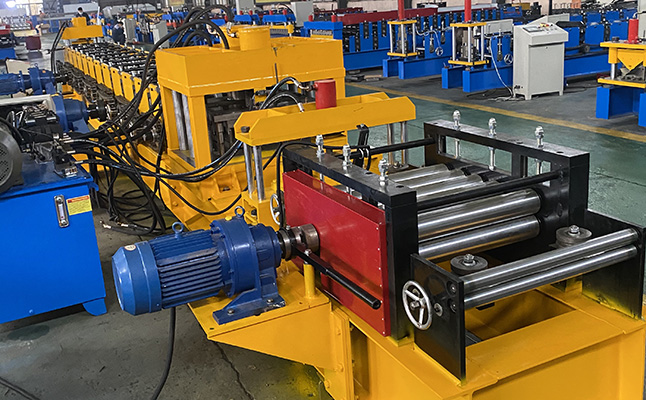
Price:
Detailed Introduction
Cold bending equipment is a mechanical equipment used to process metal sheets or strips into various specific shapes at room temperature.It is widely used in many industries such as construction,automobiles,and machinery manufacturing.The following is a detailed introduction for you:
Working principle
Cold bending equipment works based on the principle of plastic deformation of metal materials.With strip steel as raw material,the coiled strip steel is unrolled by the unwinding machine and sent to the leveling machine to eliminate the unevenness of the plate.Subsequently,the strip steel enters a forming unit composed of multiple groups of rollers.Each group of rollers is designed with a specific profile according to the shape of the profile.Under the action of each group of rollers,the strip steel gradually undergoes plastic deformation and finally forms the required cross-sectional shape.For example,in the production of C-shaped steel,the strip steel passes through a series of rollers and is bent and pressed into a C-shaped profile in turn.The formed profile is cut by the cutting machine according to the set length to become a finished product.
Main structure
Unwinder:used to support and unwind metal coils.Usually equipped with a tension control system to ensure the stability of the strip steel tension during unwinding,to avoid wrinkles and twists in the strip steel,and to affect subsequent processing.Its structure includes a reel,an expansion and contraction mechanism,a base,and a transmission device.The coil can be clamped or loosened by the expansion and contraction mechanism,and the transmission device provides power to rotate the coil.
Leveler:Flatten the uncoiled strip.Through multiple sets of leveling rollers arranged in an up-and-down staggered manner,the strip is subjected to a reverse bending force,causing elastic-plastic deformation of the strip,thereby eliminating the original unevenness.The number,diameter and spacing of the leveling rollers are adjusted according to the thickness and material of the plate processed by the equipment.Some levelers also have an automatic adjustment function,which can adjust the leveling parameters in real time according to the flatness of the strip.
Forming unit:The core component of the cold bending equipment,consisting of multiple sets of rollers.These rollers are arranged in sequence,and each set of rollers gradually deforms the strip.The design of the rollers is customized according to the cross-sectional shape and size of the target profile.It is made of high-quality alloy steel and heat-treated to improve hardness and wear resistance.The forming unit also includes a frame,a transmission system and a roller adjustment device.The frame provides support for the rollers,the transmission system ensures that the rollers rotate synchronously,and the roller adjustment device can fine-tune the position of the rollers to adapt to the production of profiles of different specifications.
Cutting machine:Cuts the continuously formed profiles according to the set length.Common ones include flying saw cutting machine and punching and shearing cutting machine.The flying saw cutting machine uses a high-speed rotating saw blade to cut the profile during its movement.It is suitable for cutting large-size and high-strength profiles,with fast cutting speed and good incision quality.The punching and shearing cutting machine uses a punch and scissors to cut the profiles through impact force.It has a simple structure and low cost,and is often used for cutting small and medium-sized profiles.
Control system:Realizes the automatic control of various parts of the cold bending equipment.It uses PLC(programmable logic controller)or industrial computer as the core,with an operating interface(such as a touch screen).The operator can set production parameters such as unwinding speed,leveling parameters,forming speed,and cutting length on the interface.The control system monitors the operating status of the equipment in real time,such as the speed of each motor,roller pressure,profile length,etc.When a fault occurs,it will alarm and display the fault information in time,so that maintenance personnel can quickly troubleshoot the problem.
Technical parameters
Processing plate thickness:This is an important indicator to measure the processing capacity of cold bending equipment.The common range is 0.5-10mm,and different models of equipment vary.Thicker plates require greater rolling force,and higher requirements are placed on the structural strength of the equipment and the material of the rollers.
Processing plate width:generally between 100-2000mm,which determines the maximum width of the profile that the equipment can produce.Wide plate processing requires higher stability and precision control of the equipment.
Production speed:usually 5-60 meters per minute,and the production speed is affected by the type of equipment,profile specifications and complexity.Simple profiles can be produced at high speed,while complex cross-section profiles are produced at a slower speed.
Profile specifications:Cold bending equipment can produce a variety of profiles,such as C-shaped steel,Z-shaped steel,square tubes,rectangular tubes,etc.,and each profile has a specific specification range.Taking C-shaped steel as an example,the cross-sectional height is commonly 50-400mm and the thickness is 1.5-6mm.
Equipment power:The equipment power varies depending on the scale,degree of automation and processing capacity,and is generally 20-200kW.High-power equipment is used to process thick plates or high-speed production.
Copyright © Cangzhou Guochen Cold Bending Machinery Equipment Co., Ltd. Rights Reserved Sitemap | Technical Support